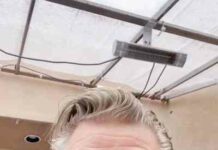The widespread use of GLP-1 weight-loss drugs, like Ozempic, has led to a surprising side effect: a distinctive facial appearance dubbed “Ozempic face.” Characterized by thin skin, a deflated jawline, dryness, and fine lines, this phenomenon is prompting a surge in new skincare products designed to counteract its effects. While the science is still emerging, experts are exploring whether these targeted formulations can truly deliver on their promises.
Зміст
The Growing Trend of GLP-1 Drugs and “Ozempic Face”
Weight-loss drugs like Ozempic are rapidly gaining popularity. Surveys indicate that nearly one in eight American adults has used these medications, with prescriptions climbing more than 300% in just four years—analysts project as many as 30 million users by 2030. Beyond reshaping bodies, these drugs are impacting faces, leading to a noticeable aesthetic change known as “Ozempic face.” Dermatologists, plastic surgeons, and users themselves are observing a gaunt, slack, and prematurely aged appearance.
Understanding the Changes: Why is This Happening?
Early explanations pointed to rapid weight loss and potential nutritional deficiencies as primary contributors. However, experts now suspect a more complex interplay of factors. GLP-1 drugs may interfere with hormone and metabolic factors, potentially disrupting skin structure and barrier function. Additionally, the loss of facial fat, which functions as an endocrine organ, can affect skin integrity—the hormone estrogen, vital for skin health, is produced by this fat. Recent research suggests these medications may even suppress the ability of dermal fat cells to stimulate collagen and elastin production.
Despite these unknowns, the consensus among experts is that this is “revolutionizing aesthetics.” While patients may initially appear healthier due to decreased inflammation, after losing about 5-10% of their body weight, their skin can become thinner and lose volume.
The New Wave of Skincare: Products Designed for “Ozempic Face”
Cosmetic companies are responding to this trend with innovative formulations. Several early products have emerged specifically to address the “4 D’s” of GLP-1 skin: deflation, density loss, deep wrinkles, and dehydration.
Here’s a look at some key players:
- , developed by plastic surgeon Marc Ronert: Combines L-ornithine, bakuchiol, HA silanol, plant collagen fragments, and kangaroo paw extract to plump, hydrate, firm, and strengthen the skin. Clinical testing has shown improvements in volume, firmness, elasticity, wrinkle-reduction, and hydration.
- DermaReverse, by Julius Few: Utilizes bioavailable retinoic acid (inspired by burn victim treatment) and a peptide complex to rebuild collagen and elastin. A peer-reviewed study in the Aesthetic Surgery Journal showed improvements in redness, pigment, fine lines, wrinkles, and related skin changes.
- SkinCeuticals’ A.G.E. Interrupter Ultra Serum: Targets glycation and collagen breakdown with ingredients like proxylane, a synthetic sugar molecule, and wild fruit flavonoids.
- Skinbetter Science’s InterFuse Treatment Cream: Supports density and barrier function with key ingredients.
What Can Skincare Really Do?
While the science is still evolving, skincare products offer a promising avenue for mitigating the effects of “Ozempic face.” However, some experts caution against expecting miracle results.
Here’s a breakdown of expert perspectives:
- Topical skincare’s limitations: Serums and creams alone cannot fully reverse volume loss, with experts suggesting injectables, fat transfers, and energy-based devices are often needed to restore structural support.
- Key Ingredients: Experts recommend ingredients like peptides, growth factors, retinoids, hyaluronic acid, ceramides, and antioxidants (vitamin C and niacinamide) to support collagen production, hydration, and skin protection.
- Chemical Perspective: Chemists like Ursula Diaz highlighted the quality and potential of certain ingredients like L-ornithine, bioavailable retinoic acid, and proxylane, but emphasized the importance of combining these with moisturizers.
The Bottom Line: A Combined Approach
While new skincare products may offer hope, a comprehensive approach is likely the most effective.
Here’s what experts are saying:
- Fat Transfer and Injectables: Replacing lost facial fat through fat transfer offers the thickest amount of stem cells. Injectables like Sculptra and Restylane can also stimulate collagen.
- Energy-Based Devices: Technologies like Ultherapy, Fraxel, and Morpheus8 can help tighten and rejuvenate skin.
- Cautious Optimism: While the science is still thin, the emergence of skincare specifically targeted toward addressing the effects of GLP-1 medication is encouraging.
- Continued Research Needed: Further research is essential to fully understand the mechanisms behind “Ozempic face” and the most effective strategies for addressing it









































